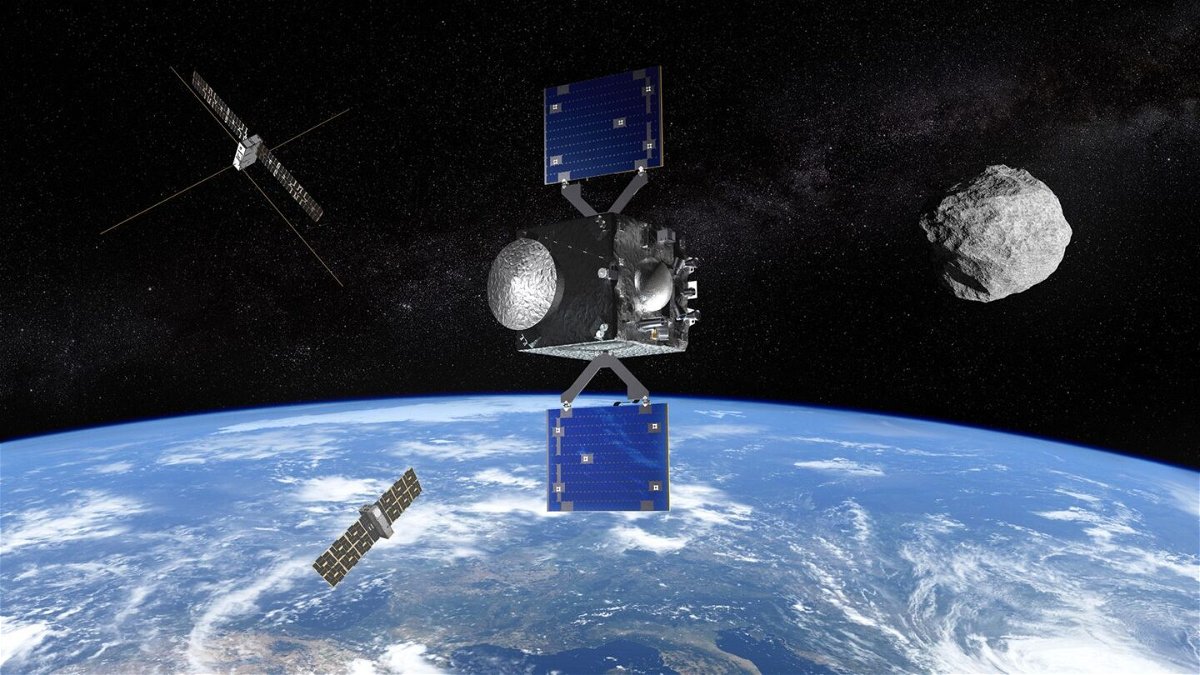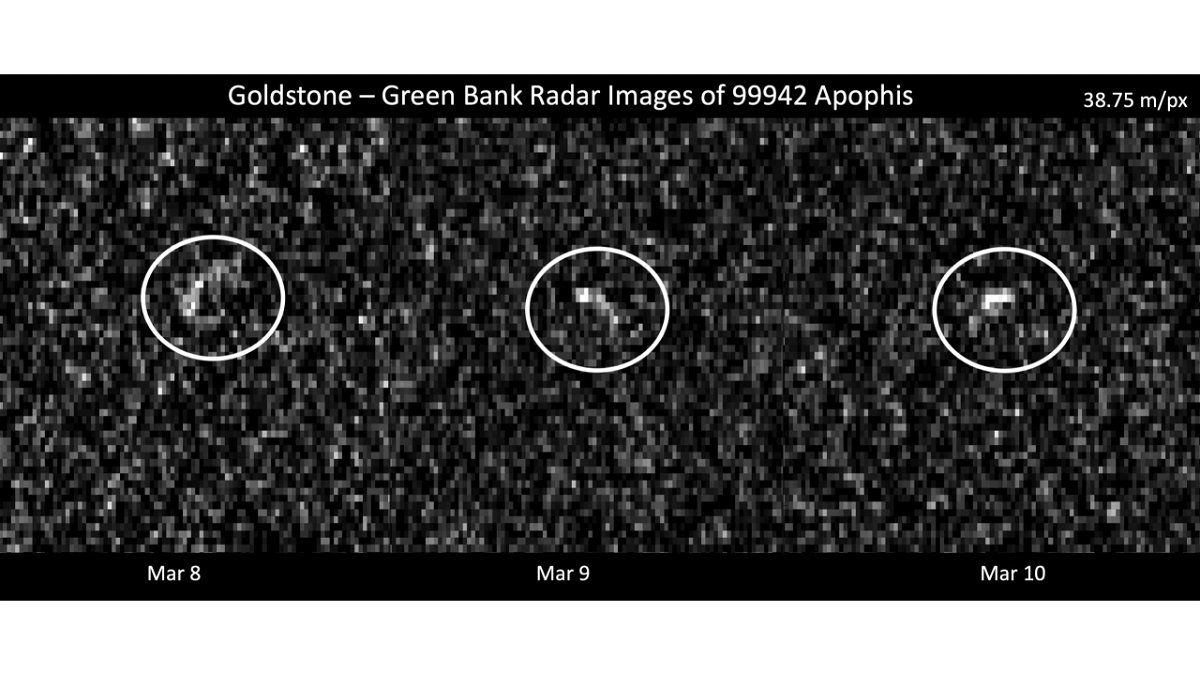A cruise liner-size asteroid will come closer to Earth than some satellites. A new mission may be racing to meet it

By Ashley Strickland, CNN
(CNN) — When a cruise liner-size asteroid comes within 19,883 miles (32,000 kilometers) of Earth on April 13, 2029, it won’t be alone.
The European Space Agency has announced that its new Ramses spacecraft may accompany the asteroid Apophis before and after its safe, albeit rather close, pass of Earth.
The space rock, measuring 1,230 feet (375 meters) across, will come closer to our planet than satellites in its orbit and 10 times nearer than the moon. Apophis will come so close to Earth that it will be visible to the naked eye for around 2 billion people living across most of Europe, Africa and parts of Asia.
To arrive at Apophis in February 2029, Ramses must launch in April 2028. Preparatory work has already begun on the mission using existing resources to meet this ambitious goal, according to the agency. But the ultimate decision on committing to the mission will take place at ESA’s Ministerial Council meeting in November 2025.
First discovered in 2004, Apophis is named for the Egyptian god of chaos and darkness and believed to be shaped like a peanut. Initially, astronomers were concerned that the space rock might impact Earth in 2029 and 2068, but subsequent observations have ruled out any risk of Apophis posing a threat to the Earth for the next century, according to NASA’s Center for Near-Earth Object Studies.
Scientists at the center use radar and telescopes to study near-Earth objects and understand the dangers they may pose to the planet. They maintain a risk list, tracking asteroids with orbits that bring them close to our world — close enough to cause concern over a potential impact.
While Apophis doesn’t currently pose any danger, the close flyby presents a rare opportunity. Astronomers think that an asteroid this large comes within such proximity to Earth only once every 5,000 to 10,000 years.
The ESA and NASA plan to take advantage of this unique cosmic event to increase our understanding of what happens when space rocks interact with Earth’s gravity by studying Apophis from the closest possible vantage point. Each agency will send a spacecraft to fly by and follow the asteroid.
“There is still so much we have yet to learn about asteroids but, until now, we have had to travel deep into the Solar System to study them and perform experiments ourselves to interact with their surface,” said Patrick Michel, astrophysicist and director of research at the National Centre for Scientific Research in France, in a statement. “For the first time ever, nature is bringing one to us and conducting the experiment itself.”

Up close with a stony asteroid
Apophis is of interest because it’s an S-type, or stony, asteroid — different from other space rocks visited by NASA missions, including Bennu, which is a C-type, or carbonaceous, asteroid.
C-type asteroids are made of clay and silicate rocks, while S-types are composed of silicate materials and nickel-iron.
Stony asteroids are part of the most common class of potentially hazardous asteroids that pose a threat to our planet. Understanding their composition and other details that can only be obtained from a close flyby could help space agencies determine how best to deflect such asteroids if they are predicted to be on a collision course with Earth.
The Ramses mission is unique because it would arrive at Apophis before the space rock passes our planet and then essentially ride along to capture observations. This data could show astronomers how the asteroid is altered by our planet’s gravity.
“All we need to do is watch as Apophis is stretched and squeezed by strong tidal forces that may trigger landslides and other disturbances and reveal new material from beneath the surface,” Michel said.
The forces exerted by Earth’s gravity could also trigger quakes on the asteroid.
The spacecraft would carry a suite of instruments to measure the asteroid’s shape, surface, orientation and orbit. Additionally, changes in the asteroid observed during the flyby could shed light on Apophis’ composition, mass, density, porosity and interior structure.
Keeping an eye on Apophis during and after its close approach to Earth could enable scientists to see whether there are any shifts in its orbit that could affect the likelihood of it hitting Earth in the future, as well as any changes in the asteroid’s rotation rate or to its surface.
“Ramses will demonstrate that humankind can deploy a reconnaissance mission to rendezvous with an incoming asteroid in just a few years,” said Richard Moissl, lead of ESA’s Planetary Defence Office, in a statement. “This type of mission is a cornerstone of humankind’s response to a hazardous asteroid. A reconnaissance mission would be launched first to analyse the incoming asteroid’s orbit and structure. The results would be used to determine how best to redirect the asteroid or to rule out non-impacts before an expensive deflector mission is developed.”
When spacecraft team up
While Ramses still needs to be designed, built and ultimately approved by the ESA next year, NASA’s OSIRIS-APEX mission, formerly known as OSIRIS-REx, is on track to catch up with the asteroid just after the close approach with Earth. Together, both spacecraft can collect valuable data that capture a complete portrait of how Apophis will change in response to its close brush with Earth.
As OSIRIS-REx, the spacecraft spent seven years on a round trip to the near-Earth asteroid Bennu, which included time spent surveying, touching down on and collecting a sample from the space rock.
The mission successfully delivered NASA’s first asteroid sample collected in space to Earth in September and received a new name to honor its new target: Origins, Spectral Interpretation, Resource Identification and Security-APophis Explorer.
The spacecraft won’t be able to collect a sample from Apophis, because the sample collection head was included in the capsule with the Bennu sample delivered to Earth. But OSIRIS-APEX will use its gas thrusters in an attempt to kick up dust and small rocks both on and below Apophis’ surface to study them.
“Apophis offers a great occasion to show to the world the best of international cooperation, with two missions involving different agencies working together for the best of science and planetary defense,” Michel said.
NASA and ESA have teamed up on other asteroid missions before.
In September 2022, NASA’s DART mission intentionally slammed a spacecraft into Dimorphos, a moonlet asteroid that orbits a larger parent asteroid known as Didymos. The historic test successfully changed the motion of a celestial object for the first time. Neither space rock posed a threat to Earth, but the double-asteroid system was a perfect target to test deflection technology because Dimorphos’ size is comparable to asteroids that could endanger our planet.
The ESA’s Hera mission will launch a spacecraft in October on a journey to observe the aftermath of the DART impact, reaching the asteroid pair near the end of 2026. Together with a pair of CubeSats, the mission will study the composition and mass of Dimorphos and how it was transformed by the impact and determine how much momentum was transferred from the spacecraft to the asteroid.
“The Ramses mission concept reuses much of the technology, expertise and industrial and science communities developed for the Hera mission,” said Paolo Martino, spacecraft manager for Hera who will also work on the Ramses mission, in a statement. “Hera demonstrated how ESA and European industry can meet strict deadlines and Ramses will follow its example.”
The-CNN-Wire
™ & © 2024 Cable News Network, Inc., a Warner Bros. Discovery Company. All rights reserved.
